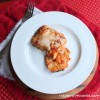Spaghetti Squash & {Feeding Toddlers with Confidence}
Thu, May 29, 2014
Disguising Healthy Foods, Dishfolio, Healthy Aperture, Itsy Bitsy Foodies Events, Itsy Bitsy Foodies Sightings, Main Dishes, Search by Course, Side Dishes, Vegetarian
 Print This Recipe
Print This Recipe
As a mom trying to nourish my two young boys, I recognize that mealtimes can sometimes be challenging and frustrating. Though exposed to the same foods and from the same parents, my boys have distinct tastes, and their appetites and interest in different foods are constantly in flux. It seems like as soon as we get into a bit of a routine, we enter some new stage with unexplored territory.
Both of my boys were extremely easy to feed as babies. When they were first introduced to solid foods, and well into their first year, they were eager to join my husband and me at the table and sample whatever we were eating. Though each son clearly had different favorites and eating tendencies, they both loved to try new foods from early on and it wasn’t difficult to feed them a well-balanced meal. However, somewhere around the two-year mark, both of them started to assert more independence, and sometimes solely on principle, they would deny foods that had been “favorites” a few weeks before. We suddenly had to scramble to try new tactics to allure them to healthy foods and to avoid the trap of only offering the basics from a typical kid menu. Fortunately, we have been able to find things that work for our family, but it has definitely been a challenge a lot of the time.
Through it all (and still), my husband and I have tried to remain calm and confident that our boys would eventually “come around.” We believe in the fact that especially if we try to set good eating examples and expose them to new foods with our varied and naturally colorful diets, maybe they will naturally come out of the independent toddler phase. (For example, though maybe they won’t eat the broccoli now, they’ll watch us eat and enjoy ours, and learn to appreciate a variety of healthy foods.) We also tried to find “work-arounds” so that even if my older son went through a phase in which he wanted grilled cheese sandwiches every day, we could at least be making them with Dave’s Killer Bread (or another hearty, whole-grain bread) to provide additional protein and nutrients. Instinctively, we agreed that we never wanted the dinner table to become a battle ground; we think mealtimes should be pleasant experiences. We now see the light at the end of the tunnel as our five-year old has now been reverting back to being an “easy” eater who claims he is constantly hungry and eager to try many foods again.
…
Adina Pearson is a Registered Dietitian Nutritionist in the Pacific Northwest. While she has always been an “everything” dietitian, since having children of her own, she’s found a passion for helping parents through feeding struggles. To this end, last summer she created a FB page in which she offers tips & ideas as well as curated web content to help parents of young children in their feeding journey. More recently she’s started the blog: Healthy Little Eaters. Her upcoming 2-week online course, Feeding Toddlers with Confidence, is a collaborative project with New York Pediatric Dietitian, Natalia Stasenko. For further information on this online course on feeding toddlers, see this link: Feeding Toddlers with Confidence. Itsy Bitsy followers will get a 30% discount with this promotional code: ItsyBitsy30
I quickly became intrigued with Healthy Little Eaters and Feeding Bytes because I realized that both Adina and Natalia address many of the same issues that my young family has faced. I also really like their approach of non-confrontational mealtimes, and child-led, independent feeding. To give you an idea of what to expect in the program, below are a few frequently-asked questions, as well as a nutritious, family-friendly recipe:
What changes can parents expect as their children transition from infants to toddlers?
Infants, early in their solid food experience, tend to be pretty open to flavors. Once they are ready to eat, they are fairly adventurous and eager to try whatever they can. They might even make a face that signals “ewww” when they try something new, but then 10 seconds later, lean forward eagerly anticipating the next spoonful. However, around the age of 2, for a lot of kids, this eagerness takes a nosedive and kids become cautious about anything that seems “different” in appearance, smell or texture and may also start rejecting previously liked foods. After the age of 1, growth also slows down considerably relative to what it had been, so appetite also tend to dip and become unpredictable. So it is not unusual for “very good eaters” to suddenly become “picky,” surprising, confusing and worrying their parents. We’ll talk about this in our online class and coach parents in how to respond to this stage. The best quick response I can give for now is: eat together with your toddler and share the same foods, don’t get pushy about how much she eats, and don’t start feeding him his own separate ‘kid-food’ every time.
How does a parent know how much to feed an infant or toddler?
Infants and toddlers really don’t need as much as most people expect. The chart below will give you an idea of where to start. Keep in mind, that some children have heartier appetites and will want (and need) more than this suggests and others will have much lighter appetites and won’t want this much. Starting with a small portion and increasing as your child indicates wanting more is best.
| Age | Transitions | Portion size/frequency |
| 6-8 months | Purees, small lumps, finger foods for practicing motor skills | The first time the food is introduced – 1-2 teaspoons of single ingredient meals once or twice a day.After that – 1-3 tablespoons from 2-3 food groups twice a day. |
| 8-10 months | Lumps, finger foods, solids for snack, mealtime structure | 2-4 tablespoons from 2-3 food groups 3 times a day plus 1 solid snack |
| 10-12 months | Lumps, finger foods, ready to join family table | 2-4 tablespoons from 2-3 food groups 3 times a day, plus 2 solid snacks |
Keep in mind that the above chart is a guideline. And anything that a child can lift from the plate/tray into his mouth counts as “finger food.” Once your child is one, and has been eating food from the table with the rest of the family, you’ll have an idea of what his appetite generally is. At that point you can start with a little less than the total you think he’ll want and give him more as he indicates wanting more.
What about making healthy foods readily available to encourage light eaters to eat more throughout the day?
It’s tempting to think that light eaters just need more “encouragement” to eat and that a positive way to do this is to allow them access to “healthy” food any time they might feel inclined to munch. After all, a skinny child needs access to constant access to calories, right? Well, unfortunately that is not the case. Research has shown us that when parents put pressure on children to eat more, it makes those children want to eat less. Leaving food out “in hopes of” getting more food into your child hints at an agenda and underlying pressure that might be getting in the way of their eating. But even if you have no such agenda, grazing on “healthy” foods teaches bad habits about eating, spoils a child’s appetite for family meals, and creates the environment for kids to learn to eat for emotional reasons (like boredom).
You’ve mentioned “pressure” in your blog posts and in some of these questions, can you expand on what you mean by “pressure?”
When it comes to feeding children, pressure, is any attempt parents might make to control their child’s eating. The goal could be to get a child to eat more/less in general or eat more/less of a certain food. And the “pressure” could look positive like praise, encouragement, games or negative like force or punishment…or even variations in the middle. In the end, kids feel this attempted control and it tends to backfire, making children either turned off to eating or preoccupied with it. In our program we will teach parents the alternative to pressure and how it works in their and their child’s favor!
…
Substituting spaghetti squash for pasta has been on my list for some time now, especially because my older son loves “noodles and cheese.” By using spaghetti squash instead of noodles, you will be serving your family a healthy dose of carotenoids, Vitamin C, Niacin, Vitamin B6, Pantothenic Acid, Potassium, Manganese, anti-inflammatory omega-3 fatty acids and fiber.
The recipe at its base is very simple, and can easily be adapted to fit your family’s tastes. Simply steam the squash and serve the spaghetti squash {noodles} with marinara sauce, a combo of cheeses, or *my favorite* pesto (or pistou) sauce. The squash noodles can also be used in a more elaborate pasta dish, and served as either a side or a main dish.
- Spaghetti squash, cooked
- Marinara sauce or pesto sauce
- Parmesan cheese
- Sliced grape or cherry tomatoes, optional
- Slice the squash in half and scoop out the seeds and pulp.
- Reserve the seeds to roast if desired.
- Brush the flesh with olive oil and season with salt and pepper to taste.
- Place the squash cut side down in a baking dish.
- Pour roughly 1/2-inch water into the pan.
- Cook the squash at 375 degrees and cook the squash for 35-45 minutes. Cook time will vary depending on the size of the squash and how soft you like your squash strands.
- Check the doneness with a fork, and remove when it is tender.
- Use the fork to gently rake across the flesh of the squash to remove the “noodles.”
- Toss the noodles with pesto sauce, marinara sauce or a simple mixture of cheese, olive oil & salt and pepper.
- Serve the spaghetti squash as a side or main dish.
Tags: Feeding Bytes, Feeding Toddlers with Confidence, Healthy Little Eaters, marinara sauce, pesto sauce, spaghetti squash, spaghetti squash noodles, spaghetti squash pasta, spaghetti squash with pesto


 (No Ratings Yet)
(No Ratings Yet)
















Wonderful article, Kelsey!